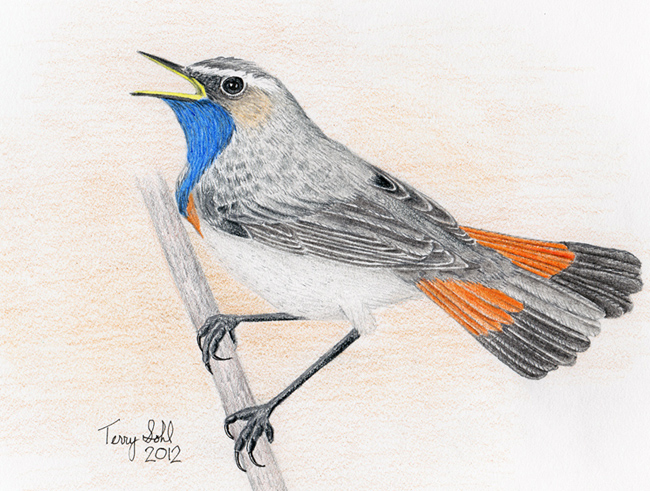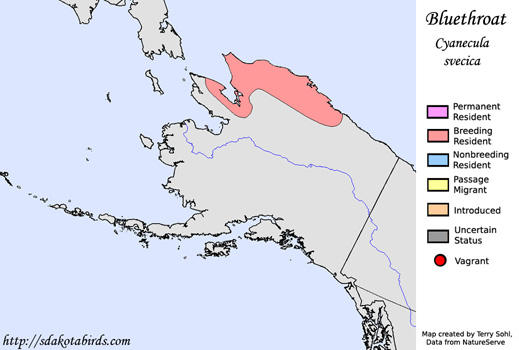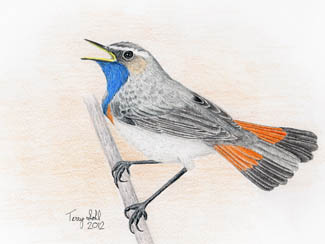| Length: 5.75 inches | Wingspan: 9 inches | Seasonality: Non-resident in South Dakota |
| ID Keys: Bluethroat and bib on male with rufous and black on chest, adult female some blue and rufous on throat/chest | ||
 The
Bluethroat is a prized bird for North American birders, a skulker of
thickets in the north Alaskan tundra. Almost always found in areas of
dense vegetation, they can be difficult to observe, but the brightly colored
males will sometimes pop out of the vegetation to sing their song. The
namesake blue throat is typically used to impress female Bluethroats, with
the males perching and displaying their throat plumage. The species is
rather common in Eurasia, and there are plumage differences between birds
found in Alaska and those found in Europe. European birds, such as the
one shown in the photo to the right, typically have a small white patch in
their middle of their throat, or the throat is entirely blue. The
Bluethroats in Alaska typically have a small rufous-colored patch in the
same location. While different in appearance, genetic analysis
indicates that Bluethroats are indeed one species.
The
Bluethroat is a prized bird for North American birders, a skulker of
thickets in the north Alaskan tundra. Almost always found in areas of
dense vegetation, they can be difficult to observe, but the brightly colored
males will sometimes pop out of the vegetation to sing their song. The
namesake blue throat is typically used to impress female Bluethroats, with
the males perching and displaying their throat plumage. The species is
rather common in Eurasia, and there are plumage differences between birds
found in Alaska and those found in Europe. European birds, such as the
one shown in the photo to the right, typically have a small white patch in
their middle of their throat, or the throat is entirely blue. The
Bluethroats in Alaska typically have a small rufous-colored patch in the
same location. While different in appearance, genetic analysis
indicates that Bluethroats are indeed one species.
Habitat: Bluethroats can be found in a variety of thick, brushy vegetation. On their Alaskan breeding grounds, they typically are found in areas of dwarf willow or birch, typically near streams. On their wintering grounds, they also prefer thick vegetation, often near water sources such as streams or lake edges.
Diet: They primarily feed on insects, and will also take spiders, earthworms, and small snails. They also will occasionally feed on berries, fruits, and seeds, mostly in colder months or perhaps when insects are less available.
Behavior: While sometimes shy and difficult to observe in the thick vegetation they call home, males will sometimes appear on an obvious open perch to sing their variables songs .
Nesting: The nests of Bluethroats are constructed under thick shrubs or at the base of other thick vegetation. The nest, built by the female, is made of grasses, twigs, moss, and other bits of vegetation, and lined with downy plant material. Both the male and female will help to raise the young.
Song: Song of the Bluethroat is variable, but typically includes a series of high staccato whistling which speeds up, and then ends with a trill or series of harsher notes.
Migration: Migratory, with breeding Alaskan birds primarily wintering in southeast Asia. They apparently migrate mostly over land, as birds migrating to and from Alaska primarily come across the Bering Strait, and are only very rare found in the Aleutian Islands.
Interactive eBird Map: Click to access an interactive eBird map of Bluethroat sightings
Similar Species: Distinctive in range, particularly the brightly colored males.
Conservation Status: There are currently no perceived major threats to Bluethroat populations, and Birdlife International cites it as a species of "Least Concern". Breeding populations in Alaska may be increasing.
Further Information: 1) WhatBird - Bluethroat
2) Audubon Guide - Bluethroat
3) BirdLife.org - Bluethroat
Image Information: Colored pencil drawing by Terry Sohl
| Click below for a higher-resolution map |
 |
| South Dakota Status: Non-resident in South Dakota |
Additional Bluethroat Images
Click for a higher-resolution version of these photos

